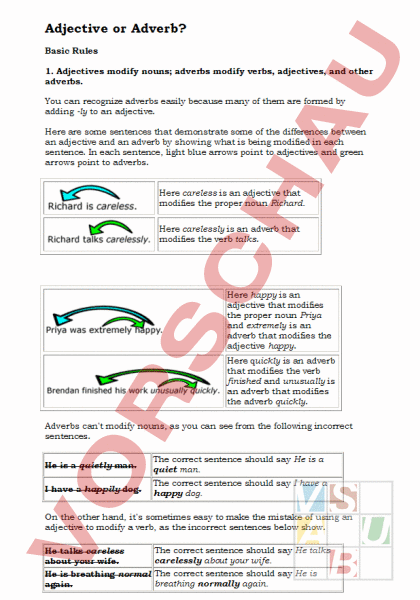Arbeitsblatt: adverbs or adjectives
Material-Details
Arbeitsblatt zu Adjektiven und Adverbien
Englisch
Grammatik
9. Schuljahr
3 Seiten
Statistik
22305
1541
43
17.07.2008
Autor/in
gloria franceschi
Land: Schweiz
Registriert vor 2006
Textauszüge aus dem Inhalt:
Adjective or Adverb? Basic Rules 1. Adjectives modify nouns; adverbs modify verbs, adjectives, and other adverbs. You can recognize adverbs easily because many of them are formed by adding -ly to an adjective. Here are some sentences that demonstrate some of the differences between an adjective and an adverb by showing what is being modified in each sentence. In each sentence, light blue arrows point to adjectives and green arrows point to adverbs. Here careless is an adjective that modifies the proper noun Richard. Here carelessly is an adverb that modifies the verb talks. Here happy is an adjective that modifies the proper noun Priya and extremely is an adverb that modifies the adjective happy. Here quickly is an adverb that modifies the verb finished and unusually is an adverb that modifies the adverb quickly. Adverbs cant modify nouns, as you can see from the following incorrect sentences. He is quietly man. The correct sentence should say He is quiet man. have happily dog. The correct sentence should say have happy dog. On the other hand, it sometimes easy to make the mistake of using an adjective to modify verb, as the incorrect sentences below show. He talks careless about your wife. The correct sentence should say He talks carelessly about your wife. He is breathing normal The correct sentence should say He is breathing normally again. again. 2. An adjective always follows form of the verb to be when it modifies the noun before the verb. Here are some examples that show this rule. Light blue arrows point from the adjective to the noun that it modifies. 3. Likewise, an adjective always follows sense verb or verb of appearance -- feel, taste, smell, sound, look, appear, and seem -- when it modifies the noun before the verb. Here are some examples that show this rule. Light blue arrows point from the adjective to the noun it modifies. Here bad is an adjective that modifies the noun cough. Using the adverb badly here would not make sense, because it would mean her cough isnt very good at sounding. Here awful is an adjective that modifies the noun oil. Using the adverb awfully here would not make sense, because it would mean that castor oil isnt very good at tasting. Here fresh is an adjective that modifies the noun air. Using the adverb freshly here would not make sense, because it would mean that the air has sense of smell that it uses in fresh manner. Here unhappy is an adjective that modifies the pronoun she. Using the adverb unhappily here would not make sense, because it would mean that she isnt very good at seeming. Here dark is an adjective that modifies the noun images. Using the adverb darkly here would not make sense, because it would mean that the images were suddenly popping into view in dark manner. Be careful to notice whether the word modifies the subject or the verb in the sentence. If the word modifies the subject, you should use an adjective. If the word modifies the verb, you should use an adverb. The difference is shown in the following pair of sentences. Here sweet is an adjective that modifies the noun apple. Using the adverb sweetly here would not make sense, because it would mean that the apple can smell things in sweet manner. Here carefully is an adverb that modifies the verb smells. Using the adjective careful here would not make sense, because it would mean that the dog gives off an odor of carefulness. Avoiding Common Errors Bad or Badly? When you want to describe how you feel, you should use an adjective (Why? Feel is sense verb;see rule #3 above). So youd say, I feel bad. Saying you feel badly would be like saying you play football badly. It would mean that you are unable to feel, as though your hands were partially numb. Good or Well? Good is an adjective, so you do not do good or live good, but you do well and live well. Remember, though, that an adjective follows sense-verbs and beverbs, so you also feel good, look good, smell good, are good, have been good, etc. (Refer to rule #3 above for more information about sense verbs and verbs of appearance.) Confusion can occur because well can function either as an adverb or an adjective. When well is used as an adjective, it means not sick or in good health. For this specific sense of well, it OK to say you feel well or are well -- for example, after recovering from an illness. When not used in this health-related sense, however, well functions as an adverb; for example, I did well on my exam.
